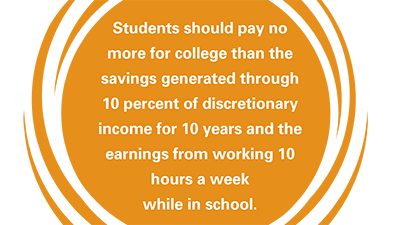New framework defines affordability in 3 dimensions–savings over time, percent of income and student work
INDIANAPOLIS – With college costs rising and students’ debt load mounting, there’s a growing national debate over how to make higher education affordable. What’s missing from the conversation is a clear and common understanding of what “affordable” means to students and families. To address that gap and reset the conversation around college affordability, Lumina Foundation today released the Affordability Benchmark for Higher Education—a framework that clearly defines college affordability in terms of what families and students can and should pay.
By establishing a shared definition of affordability, the benchmark sets the stage for policymakers and higher education institutions to work together to build a system that’s affordable for every student. It also enables students and their families to better understand –and plan for –the financial realities of college.
“The meteoric rise of higher education costs–and the growing student debt that has come with it—threatens the vitality of our postsecondary system and thwarts many Americans from earning the education beyond high school that is so critical to success,” said Jamie Merisotis, president and CEO of Lumina Foundation. “We must make it a national priority to address this issue. The Affordability Benchmark is designed to reset the national dialogue around how to fix the problem by providing a clear, concrete definition of what ‘affordable’ means for today’s students and families.”
The Affordability Benchmark assumes families and students pay for college across three dimensions—family savings as a percent of income and for a set number of years, and students’ work while in school. For college to be affordable, students and families must be able to cover its cost across all three dimensions. The Affordability Benchmark proposes that contributions from each source be capped as follows:
- Families save 10 percent of their discretionary income;
- Saving over 10 years; and
- Students work 10 hours per week while attending college.
Under this “Rule of 10” benchmark, the amount defined as affordable would be based on their particular circumstances. For example, families living below 200 percent of the poverty level should not be expected to contribute savings or take on debt, according to the benchmark, but the 10 hour a week contribution from students’ work, which amounts to about $3,625 per year, would be feasible. A family making an average of $100,000 might be able to contribute $51,500 based on saving 10 percent of income over 10 years.
“The idea behind this framework isn’t to create a one-size-fits-all approach, but rather to provide guidelines that can be easily understood and tailored to individual students,” said Zakiya Smith, strategy director at Lumina Foundation overseeing the work. “By clearly defining affordability, we hope this benchmark has the potential to dramatically change the national conversation around what families should be expected to pay for college and bring us closer towards making college within reach for all.”
The benchmark comes at a critically important time. College prices have ballooned by an average of 45 percent in real dollars over the last decade, even as household income has declined by 7 percent.
The burden of paying for college can deter students from enrolling and earning their degrees, and that’s particularly true for low-income students. Only 9 percent of students from the lowest income quartile have bachelor’s degrees, compared with 54 percent from the highest quartile. That’s especially troubling given that labor economists project 65 percent of all jobs will require postsecondary education by 2020.
“Our success as a nation is inextricably linked with our ability to ensure all people, regardless of income, have access to higher education opportunities, and we are failing to meet that goal,” said Dewayne Matthews, vice president of strategy development at Lumina Foundation. “We must knock down obstacles for low-income students on the path to college, including cost, which is a significant obstacle.”
In the coming weeks, Lumina will work with a number of stakeholder organizations to determine ways policymakers and higher education leaders can apply the Affordability Benchmark to rethink how students pay for college. Additional issues that will need to be considered include examining appropriate levels of state support to make the benchmark realistic for public colleges; how best to ensure quality in the context of affordability; and ways to improve need-based aid to meet the benchmark.
Related news
- Measuring College Affordability: Lumina’s Rule of 10 and the Federal EFC | Nov. 10. 2015
- Michigan wants Lansing, schools to lead on college affordability | Bridge | Sep. 15, 2015
- Defining College Affordability | Inside Higher Ed | Aug. 19, 2015
- Why College Affordability Is So Difficult to Define | The Chronicle of Higher Education | Aug. 19, 2015
- A New Way to Define ‘Affordable’ College | Time | Aug. 19, 2015
- This guideline could help families figure out how much to pay for college | The Washington Post | August 19, 2015
- Lumina Foundation Proposes College Affordability Benchmark | Philanthropy News Digest | August 21, 2015
